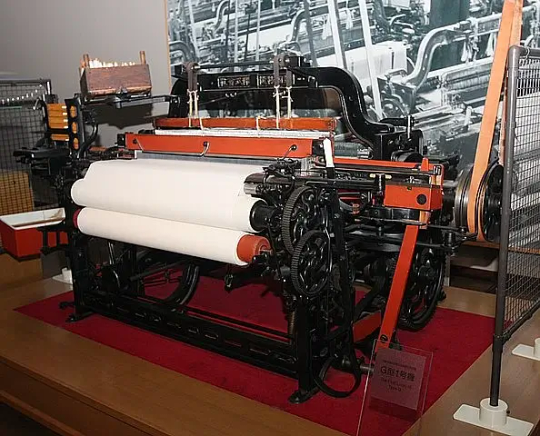#HistoryofToyota
Text
Brief History of Toyota Motor Corporation

The Toyota Motor Corporation is a world-renowned car manufacturer that has been producing some of the most reliable vehicles since its inception on August 28, 1937.
Founded by Kiichiro Toyoda, the company initially produced only a few cars per month but quickly grew to become one of the most successful car manufacturers in the world.
As one of the largest automotive companies in the world, Toyota Motor Corporation's expansive vehicle line-up consists of 14 models.

1924 Non-Stop Shuttle Change Toyoda Automatic Loom, Type G. Photo by Morio. Wikimedia.
Toyota’s Early Years
The Toyoda Model G Automatic Loom was created in 1924 by Sakichi Toyoda. The Toyota Production System later incorporated the jidoka principle, which states that when a problem arises, the machine automatically stops.
A modest production line was used to construct looms. The automatic loom invention was sold to the British business Platt Brothers in 1929, providing the seed money for the creation of automobiles.
Toyoda Automatic Loom Works formed an Automobile Division on September 1, 1933, and formally proclaimed its plan to start manufacturing automobiles on January 29, 1934, both under the guidance of Kiichiro Toyoda, the founder's son.
On August 28, 1937, the name “Toyota Motor Co.” was officially registered as a separate entity from Toyoda Automatic Loom Works Ltd.
Under Kiichiro’s leadership, Toyota developed revolutionary production methods that would become known as the “Toyota Production System." This system combined both human and machine labor to achieve greater efficiency and cost savings than traditional mass production methods at the time.
By 1941, 70% of all cars sold in Japan were Toyotas – making it by far the leading car manufacturer in Japan at that time.
In 1945, following World War II, Toyota began producing larger vehicles for export to America under its new brand name – Lexus – to compete more effectively with American automakers like General Motors and Chrysler Corporation.
At this time, only luxury cars were exported from Japan; however, this changed when Honda Motors began exporting smaller cars to America starting in 1968 (the same year that Honda introduced their Civic model).
This shift forced Toyota to focus on developing smaller cars for export as well to remain competitive.
Post-War Success
The story of Toyota wasn't always one of success and recognition. In the aftermath of World War II, the company was struggling to survive, facing a ravaged economy, limited resources, and a scarcity of skilled labor.
Yet despite these challenges, Toyota managed to rise from the ashes, transform itself into a global powerhouse, and set a new standard for excellence in the automobile industry.

Toyota Production System. Photo by Avi Alpert. Flickr.
Embracing Lean Manufacturing
One of Toyota's key strategies for success was the development of the "Toyota Production System," a groundbreaking approach to manufacturing that focused on maximizing efficiency, reducing waste, and empowering workers.
This system, also known as "lean manufacturing," helped Toyota streamline operations, eliminate unnecessary costs, and create higher-quality products at a faster pace than its competitors.
By instilling a culture of continuous improvement and empowering employees to identify and solve problems, Toyota was able to achieve levels of productivity and quality that were previously thought impossible.

Model car factory production line. Photo by Mr Wabu. Flickr.
The Power of Kaizen
Another critical factor in Toyota's success was the concept of "kaizen." Kaizen is a Japanese term that means "continuous improvement," and it's a philosophy that Toyota has ingrained into its DNA.
The idea behind kaizen is that even the smallest improvements, made consistently over time, can lead to significant gains in efficiency, quality, and profitability. Toyota encourages its employees to constantly look for ways to improve their work and the company's processes.
By embracing kaizen, Toyota has been able to stay at the forefront of the automobile industry and maintain its position as a leader in innovation and quality.
Customer First
Toyota has always placed a high priority on its customers, recognizing that their satisfaction is critical to the company's success. To this end, Toyota has invested heavily in research and development, using customer feedback to inform its product designs and features.
It has also established a reputation for exceptional customer service, striving to provide personalized attention and support to every customer.
By putting the customer first, Toyota has built a loyal following of customers who trust and value the company's products and services.
Global Expansion
Toyota's postwar success was not limited to Japan. The company recognized the importance of expanding its operations globally and set out to establish a strong presence in markets around the world.
Toyota began exporting its vehicles in the 1950s and gradually expanded its production and sales operations to countries such as the United States, Australia, and the United Kingdom.
In the years since Toyota has continued to grow and now operates production facilities and sales networks in more than 190 countries and territories.
This global expansion has allowed Toyota to capitalize on new markets, diversify its customer base, and further solidify its position as a world leader in the automobile industry.

TOYOTA MIRAI. Photo by niconico0. Flickr.
Sustainability and Social Responsibility
In recent years, Toyota has made a concerted effort to be a more socially responsible company, embracing sustainability as a core value. Toyota has invested heavily in green technologies, such as hybrid and electric vehicles, and has pledged to reduce its carbon emissions and environmental impact.
It has also prioritized corporate social responsibility initiatives, such as supporting disaster relief efforts and promoting education and community development.
By taking a proactive approach to sustainability and social responsibility, Toyota has demonstrated its commitment to being a responsible and ethical global business leader.

Toyota Headquarter Toyota City. Photo by Chris 73. Wikimedia.
Global Expansion
In 1957, Toyota established its U.S. subsidiary called Toyota Motor Sales USA Inc., making it one of the earliest Japanese companies to expand into international markets.
By 1966 they had sold their millionth vehicle in North America and continued to grow throughout South America as well as Europe and Asia over time.
In 1984, they established their luxury division Lexus which became highly successful almost immediately after launch.
Conclusion
Toyota has become one of the world’s leading automobile manufacturers due to its commitment to innovation, customer service, and global expansion. The company has embraced kaizen principles which focus on continuous improvement in order to remain at the forefront of automotive technology.
Toyota also places a high priority on sustainability and social responsibility initiatives that demonstrate their dedication to being an ethical business leader.
With operations now reaching countries all around the world, it is clear that Toyota’s strategy for success is working - showing no signs of slowing down anytime soon!
Sources: THX News, Wikipedia & Toyota.
Read the full article
#AkioToyoda.#HistoryofToyota#Kaizen#SocialResponsibility#Toyota#ToyotaHistory#ToyotaMotorCorporation#ToyotaMotorSalesUSA
0 notes